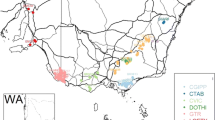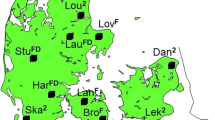Abstract
Danish tree breeder Ib Thulin and his coworkers John Miller, Geoff Sweet and Egon Larson had the task of establishing provenance trials of numerous species from around the world. Ib initiated the first steps of radiata pine breeding through plus-tree selection in Kaingaroa Forest and in planting the first clonal seed orchards. He focused on the local populations of radiata pine, which, it turned out, were a hybrid mix of the Monterey and Ano Nuevo Californian provenances. This was a fortunate choice as became apparent later.
Access provided by Autonomous University of Puebla. Download chapter PDF
Similar content being viewed by others
Keywords
It is a shame that Ib Thulin is no longer in the office next door, where he was, more or less from the time he arrived in NZ until he retired in 1983. He would have explosively corrected the inevitable errors in this account. Ib arrived in NZ in 1951 and in the next one and a half decades accomplished an incredible amount of work, making great progress in the tree improvement of several species. The practical work was done by several field technicians, assisted by John Miller, Geoff Sweet and by Egon Larsen who did much of the species and provenance seed collection in the Pacific Northwest of the USA. Previous experience with using commercial seedlots to characterise provenances had not been good (Fig. 1.1).
Provenance trials in a range of species were created by Ib and his colleagues from 1953 onwards, from designing the sampling, collecting the seed and raising the stock to finding sites and laying out the trials. The designs were apparently all conceived by Ib, and, in some cases, he was able to access seed of provenances of various European species through the generosity of his European tree breeder contacts. He had been trained by Syrach Larsen at Horsholm in Denmark, one of the very few ‘fathers’ of tree breeding in Europe, and had worked there as a tree breeder for 4 years (with a year’s assignment to Greenland) before emigrating to NZ. He had also visited or been in touch with several forest geneticist/tree breeders in Europe and Scandinavia. He was also lucky to have an important backer in New Zealand Forest Service Head Office, Alan Entrican.
The species tested in provenance trials (long-term field experiments) by region included:
-
Eastern USA: Pinus (P.) banksiana, P. resinosa, P. strobus, P. taeda, P. elliottii
-
Europe and Asia: P. pinaster, P. nigra, P. sylvestris, Picea abies, Larix decidua, Larix kaempferi (Leptolepis)
-
Western USA: P. radiata, P. muricata, P. attenuata, P. contorta, P. ponderosa, P. monticola, P. lambertiana, Pseudotsuga menziesii, Tsuga heterophylla, Picea sitchensis, Thuja plicata, Cupressus macrocarpa (and its hybrid with Ch. nootkatensis, Leyland cypress), Abies grandis, Abies spp.
An additional 16 species of Mexican pines were collected by Ib and Egon Larsen in Mexico in 1965 (when he interviewed CJAS in Raleigh, NC for a future job). When later assessed at age 32, the best species were P. patula, P. ayacahuite, P. douglasiana, P. michoacana, P. pseudostrobus and P. tenuifolia.
Martin Bannister’s research on progeny and provenance variation in radiata pine started with a 30 family OP test he established in Pigeon Valley near Nelson (results were published in the NZ Journal of Botany). A massive series of provenance-progeny trials of radiata pine (from seed collected by Margot Forde, a famous agricultural seed collector) was initiated in 1962 and the first field planting done in 1964. These trials were not included in the TI programme, and Martin remained quite isolated from the TI group.
Rowland Burdon arrived back from Aberystwyth in 1968, and from then on, we became increasingly integrated and eventually became ‘Genetics and Tree Improvement’, from the previously separate ‘Genetics’ and ‘Tree Improvement’.
The experiments conducted covered native populations, Ano Nuevo, Monterey and Cambria from the Californian mainland, Cedros Island and Guadalupe Island, and two New Zealand (NZ) populations. All five native populations, and two NZ populations, with 50 open pollinated families from each, were planted at two contrasting sites in Kaingaroa. The late Ken Eldridge and Tony Firth carried out a more comprehensive seed collection in the native populations of radiata pine, and these formed a large series of 11 trials across NZ.
Ib started the Pinus radiata breeding programme in 1953, focussing entirely on the New Zealand land races that had developed since the first introductions of radiata pine, beginning in the 1860s. Very intensive selection of plus trees was done, mainly in Kaingaroa Forest but with some, including the famous 850-55, selected in Kinleith Forest of NZ Forest Products (based in Tokoroa).
Very large areas (23,000 ha) were searched, but no more than 25 trees were selected, of which only 14 clones were thought good enough for grafting and planting: 10 ha. of seed in the needle-cast orchard in Kaingaroa and another 10 ha. at Gwavas Forest in Hawkes Bay. Both plantings were in 1957.
There was extreme emphasis on intensive phenotypic selection for vigour, an even branching habit, and good stem straightness, but little realisation that narrow sense heritability for many traits might be too low for effective selection. Thus, progeny testing was apparently given little urgency, which subsequently caused problems in the early breeding and seed orchard programme.
In 1960, NZ forestry was still far from being based on a single species. The needle-cast fungus Dothistroma pini had not yet arrived, and the Californian provenances of P. ponderosa and the Corsican provenance of P. nigra were still popular for use on harder sites. P. contorta was regarded as an extreme frost-site species for planting at higher elevations. Douglas-fir (Pseudotsuga menziesii) was perhaps the most important of the ‘alternative’ species for softwood timber production. Genetic improvement of these species, however, was still only on the horizon. Eucalypts had not yet been seriously considered as industrial species for solid wood production, though Harry Bunn was pursuing some of these, including stringybark E. muelleriana. New Zealand Forest Products Ltd. (NZFPL) would soon establish plantations in their own forests of E. regnans and E. fastigata for blending with pine fibre for the production of newsprint.
This was the environment in which Ib and his team were operating during the 1950s and early 1960s, an environment that was to change a lot with challenges introduced by the arrival of the needle-cast fungus Dothistroma pini about 1965, which more or less eliminated P. ponderosa and P. nigra as commercial species from the North Island, though they were still usable in low rainfall/higher-altitude areas in the South Island. Dothistroma necessitated a lot of research and practical effort with radiata pine to achieve control.
Author information
Authors and Affiliations
Rights and permissions
Copyright information
© 2019 Springer Nature Switzerland AG
About this chapter
Cite this chapter
Shelbourne, C.J.A. (2019). The Influence of Ib Thulin. In: Tree Breeding and Genetics in New Zealand. Springer, Cham. https://doi.org/10.1007/978-3-030-18460-5_1
Download citation
DOI: https://doi.org/10.1007/978-3-030-18460-5_1
Published:
Publisher Name: Springer, Cham
Print ISBN: 978-3-030-18459-9
Online ISBN: 978-3-030-18460-5
eBook Packages: Biomedical and Life SciencesBiomedical and Life Sciences (R0)





